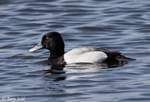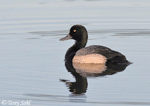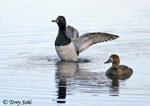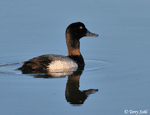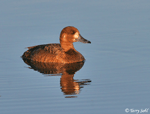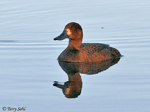| Length: 16 to 20 inches | Wingspan: 30 to 34 inches | Seasonality: Migrant |
| ID Keys: Black head, neck, and breast, large blue-gray bill, white sides and belly. Compare to the very similar Lesser Scaup. | ||
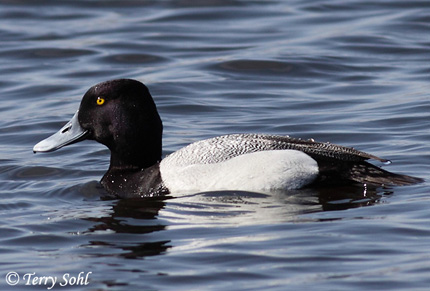 The Greater Scaup is very similar in appearance
to its close cousin, the Lesser Scaup, but
is generally found further north in the summer, is only rarely found very far
inland in winter, and can also be found in northern Europe and Asia. See
notes below for differentiating between Greater and Lesser Scaup.
The Greater Scaup is very similar in appearance
to its close cousin, the Lesser Scaup, but
is generally found further north in the summer, is only rarely found very far
inland in winter, and can also be found in northern Europe and Asia. See
notes below for differentiating between Greater and Lesser Scaup.
Habitat: Found on lakes and bogs near the treeline during the summer breeding season. In winter, found mainly on coastal estuaries and bays, with smaller numbers on inland lakes.
Diet: Feeds heavily on mollusks, including snails, clams, oysters, and mussels, as well as crustaceans and insects. Also feeds on plant material.
Behavior: A diving duck, primarily foraging by diving from the water's surface and swimming underwater for food items. They will also sometimes act like dabbling ducks, swimming on the water's surface and grabbing food items from the surface or by dipping the head below the surface.
Breeding: Non-breeder in South Dakota.
Song: Generally quiet, but with a loud scaup note, as well as soft whistling by the courting male..
Migration: Summers in Northern Canada and Alaska. Winters along both the Pacific and Atlantic coastlines of North America.
Interactive eBird Map: Click here to access an interactive eBird map of Greater Scaup sightings
Similar Species: Lesser Scaup, Ring-necked Duck. Greater Scaup is extremely similar to Lesser Scaup, but with a different head shape (more rounded, highest point near front of head), a larger bill, and a longer white wing stripe visible in flight.
Conservation Status: Generally abundant and stable throughout most of its range.
Further Information: 1) USGS Patuxent Bird Identification InfoCenter, Greater Scaup
3) Audubon Guide - Greater Scaup
Photo Information: May 1st, 2009 - Lake Thompson, South Dakota - Terry Sohl
Additional Photos: Click on the image chips or text links below for additional, higher-resolution Greater Scaup photos.
| Click on the range map for a higher-resolution view |
 |
| South Dakota Status: Rare to uncommon migrant in the eastern part of the state, casual in the western part. |
Additional Greater Scaup Photos
Click for a higher-resolution version of these photos
